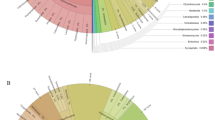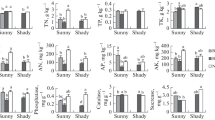Abstract
The aim of this study was to determine microbial biomass carbon and diversity at three topographic positions (ridge, middle slope and valley bottom) at varying periods after the occurrence of wildfire. The purpose of this study was to enhance knowledge on the microbiological status of post-fire sites for a better estimate of the success of their restoration. Results showed that the biomass carbon and microbial diversity were affected by fire: the averages of the burnt plots were <50% of those of the unburnt plots. In addition, the biomass carbon at the sites studied 3 years after and 25 years after fire, and 5 months after and 9 years after fire, were not significantly different from each other. On the other hand, the site studied 5 months after fire showed the highest microbial diversity, followed by the ones studied 3, 25, 9 and 6 years after fire. In terms of topographic position, the ridge was shown to be the most affected by fire. These results show that fire can adversely affect the microbial biomass carbon and microbial diversity of the soil, the recovery of which may take a long time.






Similar content being viewed by others
References
Acea MJ, Carballas T (1996) Changes in physiological groups of microorganisms in soil following wildfire. FEMS Microbiol Ecol 20:33–39
Aon MA, Colaneri AC (2001) Temporal and spatial evolution of enzymatic activities and physico-chemical properties in an agricultural soil. Appl Soil Ecol 18:255–270
Bååth E, Frostegård Å, Pennanen T, Fritze H (1995) Microbial community structure and pH response in relation to soil organic matter quality in wood-ash fertilized, clear-cut or burned coniferous forest soils. Soil Biol Biochem 27:229–240
Blackwood CB, Marsh T, Kim S, Paul EA (2003) Terminal restriction fragmnent length polymorphism data analysis for quantitative comparison of microbial communities. Appl Environ Microbiol 69:926–932
Bollen GJ (1969) The selective effect of heat treatment on the microflora of a greenhouse soil. Neth J Plant Pathol 75:157–163
Burt TP, Butcher DP (1985) Topographic controls of soil moisture distribution. J Soil Sci 36:469–486
Chandler C, Cheney P, Thomas P, Trabaud L, Williams D (1983) Fire in forestry, vol 1. Forest fire behavior and effects. Wiley, New York
Choromanska U, DeLuca TH (2002) Microbial activity and nitrogen mineralization in forest mineral soils following heating: evaluation of post-fire effects. Soil Biol Biochem 34:263–271
Choung Y, Lee B, Cho J, Lee K, Jang I., Kim S, Hong S, Jung H, Choung H (2004) Forest responses to the large-scale east coast fires in Korea. Ecol Res 19:43–54
Dumontet S, Dinel H, Scopa A, Mazzatura A, Saracino A (1996) Post-fire soil microbial biomass and nutrient content of a pine forest soil from dunal Mediterranean environment. Soil Biol Biochem 28:1467–1475
Dunbar J, Ticknor LO, Kuske CR (2000) Assessment of microbial diversity in four southwestern United States soils by 16S rRNA gene terminal restriction fragment analysis. Appl Environ Microbiol 66:2943–2950
Dunn PH, Barro SC, Poth M (1985) Soil moisture affects survival of microorganisms in heated chaparral soil. Soil Biol Biochem 17:143–148
Entry JA, Stark NM, Loewenstein H (1986) Effect of timber harvesting on microbial biomass fluxes in a northern Rocky Mountain forest soil. Can J For Res 16:1076–1081
Florinsky IV, McMahon S, Burton DL (2004) Topographic control of soil microbial activity: a case study of denitrifiers. Geoderma 199:33–53
Fritze H, Pennanen T, Pietikäinen J (1993) Recovery of soil microbial biomass and activity from prescribed burning. Can J For Res 23:1286–1290
Fritze H, Smolander A, Levula T, Kitunen V, Mälkönen E (1994) Wood-ash fertilization and fire treatments in a Scots pine forest stand: effects on the organic layer, microbial biomass, and microbial activity. Biol Fertil Soils 17:57–63
Fuhrman JA, Griffith JF, Schwalbach MS (2002) Prokaryotic and viral diversity patterns in marine plankton. Ecol Res 17:183–194
Garcia EG., Andreu V, Rubio JL (2004) Spatial patterns of soil temperatures during experimental fires. Geoderma 118:17–38
Gondard H, Romane F, Aronson J, Shater Z (2003) Impact of soil surface disturbances on functional group diversity after clear-cutting in Aleppo pine (Pinus halepensis) forests in southern France. For Ecol Manage 180:165–174
Hernandez T, Garcia C, Reinhardt L (1997) Short-term effects of wildfire on the chemical, biochemical, and microbiological properties of Mediterranean pine forest soils. Biol Fertil Soils 25:109–116
Jenkinson DS (1988) Determination of microbial biomass carbon and nitrogen in soil. In: Wilson JR (eds) Advances in nutrient cycling in agricultural ecosystems. CAB International, Wallingford, pp 368–386
Jenkinson DS, Ladd JN (1981) Microbial biomass in soil: measurement and turn-over. In: Paul AE, Ladd JN (eds) Soil biochemistry, vol 5. Dekker, New York, pp 415–471
Jensen M, Michelsen A, Gashew M (2001) Responses in plant, soil inorganic and microbial nutrient pools to experimental fire, ash and biomass addition in a woodland savanna. Oecologia 128:85–93
Jurgens G, Saano A (1999) Diversity of soil Archaea in boreal forest before, and after clear-cutting and prescribed burning. FEMS Microbiol Ecol 29:205–213
Kumar JD, Sharma GD, Mishra RR (1992) Soil microbial population numbers and enzyme activities in relation to altitude and forest degradation. Soil Biol Biochem 24:761–767
Lane DJ, Pace B, Olsen GJ, Stahl DA, Sogin ML, Pace NR (1985) Rapid determination of 16S rRNA sequences for phylogenetic analysis. Proc Natl Acad Sci USA 82:6955–6959
Li Q, Allen HL, Wollum AG II (2004) Microbial biomass and bacterial functional diversity in forest soils: effects of organic matter removal, compaction, and vegetation control. Soil Biol Biochem 36:571–579
Lukow T, Dunfield PF, Liesack W (2000) Use of the T-RFLP technique to assess spatial and temporal changes in the bacterial community structure within an agricultural soil planted with transgenic and non-transgenic potato plants. FEMS Microbiol Ecol 32:241–247
Lupwayi NZ, Rice WA, Clayton GW (1998) Soil microbial diversity and community structure under wheat as influenced by tillage and crop rotation. Soil Biol Biochem 30:1733–1741
Mabuhay JA, Nakagoshi N, Horikoshi T (2003) Microbial biomass and abundance after forest fire in pine forests in Japan. Ecol Res 18:431–441
Mabuhay JA, Isagi Y, Nakagoshi N (2004a) Microbial biomass, abundance and community diversity determined by terminal restriction fragment length polymorphism analysis in soil at varying periods after occurrence of forest fire. Microbiol Environ 19:154–162
Mabuhay JA, Nakagoshi N, Isagi Y (2004b) Influence of erosion on soil microbial biomass, abundance and community diversity. Land Degradation Dev 15:183–195
Michelsen A, Andersson M, Jensen M, Kjøller A, Gashew M (2004) Carbon stocks, soil respiration and microbial biomass in fire-prone tropical grassland, woodland and forest ecosystems. Soil Biol Biochem 36:1707–1717
Moore ID, Gessler PE, Nielsen GA, Peterson GA (1993) Soil attribute prediction using terrain analysis. Soil Sci Soc Am J 57:443–452
Nannipieri P, Badalucco L, Landi L (1994) Holistic approaches to study of populations, nutrient pools and fluxes: limits and future research needs. In: Ritz K, Dighton J, Giller KE (eds) Beyond the biomass: compositional and functional analysis of soil microbial communities. Dekker, New York, pp 1–33
Neary DG., Klopatek CC, DeBano LF, Ffolliott PF (1999) Fire effects on belowground sustainability: a review and synthesis. For Ecol Manage 122:51–71
Pickford SG, Fahnestock GR, Ottmar R (1980) Weather, fuel, and lightning fires in Olympic National Park. Northwest Sci 54:92–105
Pietikäinen J, Fritze H (1995) Clear-cutting and prescribed burning in coniferous forest: comparison of effects on soil fungal and total microbial biomass, respiration activity and nitrification. Soil Biol Biochem 27:101–109
Porteous LA, Seidler RJ, Watrud LS (1997) An improved method for purifying DNA from soil for polymerase chain reaction amplification and molecular ecology applications. Mol Ecol 6:787–791
Prieto-Fernandez A, Villar MC, Carballas M, Carballas T (1993) Short-term effects of a wildfire on the nitrogen status and its mineralization kinetics in an Atlantic forest soil. Soil Biol Biochem 25:1657–1664
Pyne SJ (1984) Introduction to wildland fire: fire management in the United States. Wiley, New York
Rothermel RC (1972) A mathematical model for predicting fire spread in wildland fuels. Research paper INT-115. USDA Forest Service, Intermountain Forest and Range Experiment Station, Ogden, Utah, p 40
Rothermel RC (1991) Predicting behavior and size of crown fires in the Northern Rocky mountains. General technical report INT-438. USDA Forest Service, Intermountain Research Station, Ogden, Utah, p 46
Singh JS, Raghubanshi AS, Singh RS, Srivastava SC (1989) Microbial biomass acts as a source of plant nutrients in dry tropical forest and savanna. Nature 338:499–500
Singh RS, Srivastava SC, Raghubanshi AS, Singh JS, Singh SP (1991) Microbial C, N and P in dry tropical savanna. Effects of burning and grazing. J Appl Ecol 28:869–878
Srivastava SC (1992) Microbial C, N and P in dry tropical soils: seasonal changes and influence of soil moisture. Soil Biol Biochem 24:711–714
Stotzky G (1997) Soil as an environment for microbial life. In: Van Elsas JD, Trevors JT, Wellington EMH (eds) Modern soil microbiology. Dekker, New York, pp 1–20
Vance ED, Brookes PC, Jenkinson DS (1987) An extraction method for measuring soil microbial biomass C. Soil Biol Biochem 19:703–707
Vazquez FJ, Acea MJ, Carballas T (1993) Soil microbial populations after wildfire. FEMS Microbiol Ecol 13:93–103
Wüthrich C, Schaub D, Weber M, Marxer P, Conedera M (2002) Soil respiration and soil microbial biomass after fire in a sweet chestnut forest in southern Switzerland. Catena 48:201–215
Yeates GW, Schipper LA, Smale MC (2004) Site condition, fertility gradients and soil biological activity in a New Zealand frost-flat heathland. Pedobiologia 48:129–137
Acknowledgements
We are grateful to the Hiroshima City Hall and the Fire Department for providing us with the information about the forest fires and allowing us to use the Hiroshima prefectural mesh forestry map. We are also indebted to the members of the Horikoshi Laboratory, and the Nakagoshi and Isagi Laboratory for their assistance during the experiments. We thank Martin Stephen Ward for doing the English proof-reading of this manuscript. The first author thanks Mindanao State University, her Alma Mater, for its support. This study was partially supported by the Hiroshima University COE Program for Social Capacity Development for Environmental Management and International Cooperation.
Author information
Authors and Affiliations
Corresponding author
About this article
Cite this article
Mabuhay, J.A., Isagi, Y. & Nakagoshi, N. Wildfire effects on microbial biomass and diversity in pine forests at three topographic positions. Ecol Res 21, 54–63 (2006). https://doi.org/10.1007/s11284-005-0094-1
Received:
Accepted:
Published:
Issue Date:
DOI: https://doi.org/10.1007/s11284-005-0094-1




